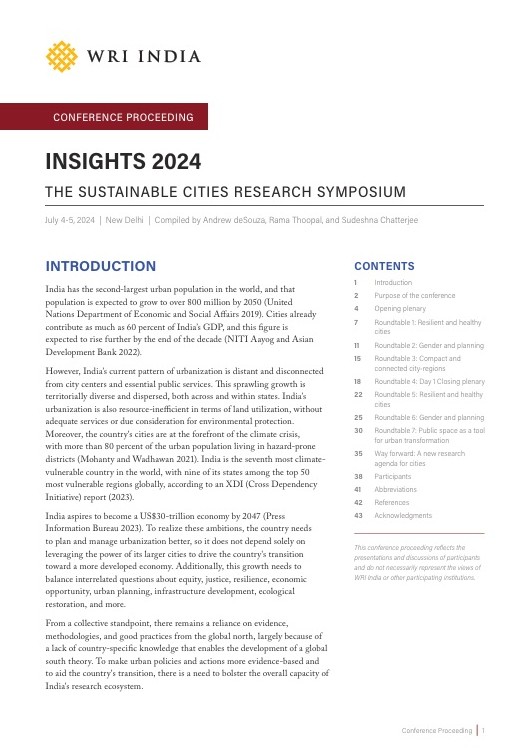Making Big Ideas Happen
With the world’s second largest population, India faces crucial economic and development decisions over the coming decades, with significant implications for people and the environment. The trajectory adopted by India to provide equitable economic development and sustainable livelihood opportunities for its 1.25 billion citizens is critical. Amidst the challenges to achieve its economic, social, environmental and political objectives, 2015 is an opportune time for India, with its new political leadership being focused on growing the economy in increasingly sustainable ways. WRI India aims to support the top five primary and most urgent challenges in the country – Urbanisation, Energy, Water, Resources and Food Security, helping India to drive sustainable development.
Why India, Why Now?
India is undergoing a period of rapid urbanisation. Between 2008 and 2030, the country’s urban population is expected to grow by 250 million. A World Bank report on India estimates environmental degradation to INR 3.75 trillion ($80 billion). The impact of growth-only oriented policies are costing the Indian economy a staggering loss of 5.7% of GDP, mainly due to urban air pollution and 3.5% of GDP due to loss of ecosystem services from degrading landscapes. These estimates do not include the choking congestion in Indian cities, which cost a 9-10% loss to GDP.
Access and affordability of regional resources drive the migration patterns which characterise urbanisation. The current trend of mass migration (300 million by 2040) is integrally linked with resource driven livelihood limitations in rural and peri-urban regions, and the promise of economic growth in cities which is far from equitably shared. Thus, the need to understand the economic geography of land, water, and energy resources of the region, and how their use impacts in turn, the quality of life and common property, such as the climate, arises. While the emergence of cities happens to be the most visible result of the urbanisation process, the root causes are embedded in a much more complex set of resource limitations and regional socio-economic conditions. Poorly-planned, sprawling cities threaten quality of life and can undermine efforts to sustain economic growth, increase energy efficiency, curb greenhouse gas emissions, and enhance public health. The immense scale of this demographic shift also presents an opportunity to build energy efficient, compact and transit-oriented cities.
A Sustainable Resource Utilisation Approach
Energy security and access to energy is fundamental to drive India’s economic growth. Access to clean energy will also boost economic prosperity while reducing the impact on public health and environment. Renewable energy as a decentralized energy system will be significant to energy price stability for consumers and creates a huge business opportunity while mitigating risks arising from dependence on non-renewable fossil fuels. In a rapidly urbanising economy, energy access and shifting to a low carbon pathway lies in India’s economic self-interest.
A strategic and timely intervention ensuring efficient utilisation of natural resources will also secure livelihood opportunities as India’s economy is closely tied to the natural resource base and climate sensitive sectors such as agriculture, water and forestry. The gross per capita water availability (including utilisable surface water and replenishable groundwater) is projected to decline from around 1,820m³ per year in 2001 to about 1,140m³ per year in 2050 due to population growth alone. More than 60% of India’s agriculture is rain-fed, and a 2°C rise in the world’s average temperatures will make India’s summer monsoon highly unpredictable, farmers may lose 9% to 25% of their net revenues, and this will dent the country’s GDP by 1.8% to 3.4%.
Adopting a regional resource development approach to influence policy implementation will enable inclusive and sustainable development and will reduce India’s vulnerability to climate risks. Building robust adaptation mechanisms at the regional scale and embedding climate risks in urban economic growth will help effectively integrate adaptation into development initiatives. Creating regional employment opportunities for the massive unskilled and skilled labor pool to restore and sustain a healthy environment will protect the natural asset base and spread the benefits of economic growth to all.
Scaling Impact to Drive Transformative Solutions
As we look to the future, creating scalable solutions to the environmental and development challenges facing India will be crucial. The Modi government plans to invest $1.2 billion in 100 smart cities over the next year. The government has also promised a 30-fold increase in solar capacity, installing 100 gigawatts by 2022. Transformative scalable solutions towards low-carbon, balanced development that inform policy design and implementation will sustain efficient utilisation of natural resources—the foundation of economic opportunity and human well-being.


